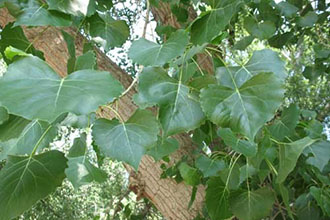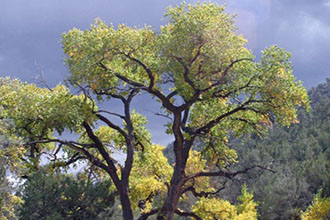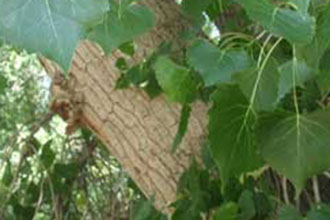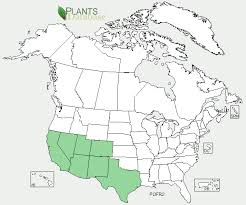Taxonomy: Kingdom - Plantae (plants). Subkingdom - Tracheobionta (vascular plants). Superdivision - Spermatophyta (seed plants). Division - Magnoliophyta (flowering plants). Class - Magnoliopsida (dicotyledons). Subclass - Dilleniidae. Order - Salicales. Family - Salicaceae (willow family). Genus - Populus L. (cottonwood). Species - Populus fremontii S. Watson (fremont cottonwood).
Ecology: Fremont cottonwood is a native, deciduous hardwood tree that ranges from 6-34 m in height and has a broad, rounded or cylindrical crown. The trunk diameter at breast height ranges from 0.5-3.9 m.The bark is smooth on the trunk, twigs, and branches of young trees, but trunk bark becomes deeply furrowed at maturity. Fremont cottonwood is inundation and siltation tolerant.
Fremont cottonwood is a shade-intolerant pioneer that typically establishes on freshly exposed alluvium, sand or gravel bars, streambanks, or other floodplain sites following winter/spring floods. Communities dominated or codominated by Fremont cottonwood and other cottonwoods (Populus spp.) are naturally maintained by periodic winter and spring floods. Dams and reservoir systems that change the natural timing and volume of water flow reduce the recruitment and vigor of Fremont cottonwood stands. In the absence of periodic flooding, succession proceeds, and the cottonwoods are eventually replaced by more shade-tolerant species (for example, western honey mesquite).
Fremont cottonwood's rapid early growth makes it well suited for revegetating riparian sites. It has been successfully planted in many riparian rehabilitation projects and is recommended for revegetating areas in the Southwest where invasive saltcedar has been removed. Fremont cottonwood, along with willows and other native plants, has also been used to restore, enhance, or create bird habitat in riparian areas...Fremont cottonwoods and other components of riparian streamside stands are important in erosion control and fisheries production; they stabilize banks and provide for thermal cover and debris recruitment. If possible, buffer strips of these woodlands should be maintained upland from streams, rivers, lakes, and ponds.



